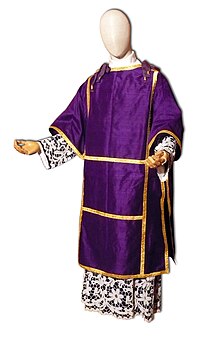Tunicle
This articlerelies largely or entirely on asingle source.(January 2020) |

Thetunicleis aliturgicalvestmentassociated withRoman Catholicism,Anglo-Catholic,andLutheranism.
Contemporary use
[edit]For a description of the tunicle, seedalmatic,the vestment with which it became identical in form, although earlier editions of theCaeremoniale Episcoporumindicated that it should have narrower sleeves. Sometimes it was also distinguished by a single horizontal band on the front and back, as opposed to the double band of the dalmatic.
History
[edit]In Rome, subdeacons had begun to wear the tunicle by the sixth century, butPope Gregory Imade them return to the use of thechasuble.They began to use the tunicle again in the ninth century, a time when it was also worn byacolytes,a custom that was widespread until the lateMiddle Agesand can still occasionally be found in some Anglican and Catholic churches for acolytes andcrucifers.In some places outside Rome, subdeacons continued to wear the tunicle even from the sixth to the ninth centuries. The ceremony by which the bishop put a tunicle on a subdeacon whom he ordained began in the twelfth century, but did not become common until the fourteenth.[1]
Romandeaconsonce wore the tunicle under the dalmatic, and the tunicle was part of the liturgical vestments of other dignitaries also. In the twelfth century it became customary forbishopsto wear both a tunicle and a dalmatic as part of theirpontifical vestments.Previously they had worn one or the other. Earlier editions of theCaeremoniale Episcoporummade the wearing of both obligatory at aPontifical High Mass,but the present edition speaks only of the dalmatic.[1]
References
[edit]- ^abBraun, Joseph (1912)..In Herbermann, Charles (ed.).Catholic Encyclopedia.Vol. 15. New York: Robert Appleton Company.
External links
[edit]- .Encyclopædia Britannica.Vol. 27 (11th ed.). 1911. p. 392.
